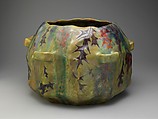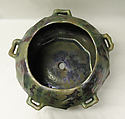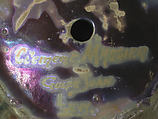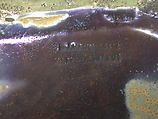Jardinière
Lucien Lévy-Dhurmer French
Clément Massier French
Not on view
The French ceramist Clément Massier began exploring the aesthetic potential of metallic luster glazes due to the influence of Lucien Lévy-Dhurmer, who became Massier's collaborator in 1887. Lévy-Dhurmer was a collector of Hispano-Moresque ceramics, a category of Spanish earthenware decorated with iridescent glazes derived from various metals such as copper, gold, and silver. The influence of these bright, reflective metallic glazes is evident in the works that Lévy-Dhurmer produced in Massier's studio during his nine years of employment there, and Massier continued to explore the effects of luster glazes long after Lévy-Dhurmer's departure in 1896.
The highly organic quality of the jardinière derives from both its irregular shape, which resembles a large gourd, and from its richly patterned luster glaze. The primary decoration consists of scattered copper-red oak leaves silhouetted against a mottled green and beige ground, and the range of iridescent colors achieved by Lévy-Dhurmer creates a sense of depth not found in more conventional glazes. The naturalism of both the form and the decoration and the originality of the conception mark this jardinière as a superb example of Art Nouveau ceramics.
Due to rights restrictions, this image cannot be enlarged, viewed at full screen, or downloaded.
This artwork is meant to be viewed from right to left. Scroll left to view more.





